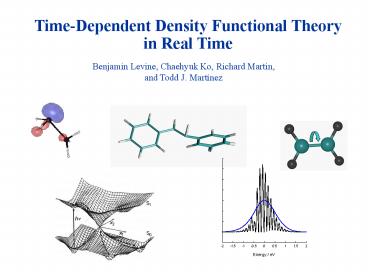TimeDependent Density Functional Theory - PowerPoint PPT Presentation
1 / 20
Title:
TimeDependent Density Functional Theory
Description:
Ab Initio Quantum Dynamics 'On-the-fly' solution of electronic and nuclear ... Tailor the requirements of quantum dynamics to quantum chemistry. and vice-versa! ... – PowerPoint PPT presentation
Number of Views:380
Avg rating:3.0/5.0
Title: TimeDependent Density Functional Theory
1
Time-Dependent Density Functional Theory in Real
Time
Benjamin Levine, Chaehyuk Ko, Richard Martin,
and Todd J. Martínez
2
Ab initio Quantum Dynamics
- Ab Initio Quantum Dynamics ? On-the-fly
solution of electronic and nuclear Schrödinger
equations - Multiple electronic states/Tunneling ? Need
quantum nuclear dynamics - Bond rearrangement ? Need to solve electronic
Schrödinger equation - Exact numerical solution of the nuclear
Schrödinger equation is impractical for large
systems. - Ab initio quantum chemistry is local
- Nuclear Schrödinger equation is global
- Not a problem in Car-Parrinello b/c Newtonian
mechanics is local - Further considerations
- Need PESs for both ground and excited states.
- Matrix elements which couple electronic states
- Minimize the number of PESs evaluations b/c of
extreme expense. - Tailor the requirements of quantum dynamics to
quantum chemistry - and vice-versa!
3
The Full Multiple Spawning (FMS) Method
- Wavefunction ansatz
Nuclear wavefunction
Electronic state
- Nuclear wavefunction on each electronic state is
a product of 3N frozen Gaussian basis functions
Position, momentum, width
Semiclassical phase
Cartesian degrees of freedom
- Classical evolution for R(t) and P(t).
- Variational principle for coefficients
Nuclear overlap matrix
Hamiltonian matrix
4
Adaptive Basis Set
- Prescription so far is insufficient
- New Basis Functions must be added to augment
classical mechanics
Spawned Basis Functions
R(t)
Nonadiabatic Coupling Regions
time
5
Multiple Spawning
Time ?
- FMS is a hierarchy of methods
- Dynamics on a single electronic state?coupled
frozen Gaussians (Heller,Metiu) - Useful Approximations in Ab Initio Dynamics
- Independent First Generation Approximation
- Different initial Gaussian wavepackets are
uncoupled - Includes coherences between basis function and
its children - Neglects coherence between initial basis
functions - Saddle-Point Approximation for Integrals
- Use locality of Gaussians to evaluate integrals
using local information
Centroid of ?i?j
6
Ab initio Multiple Spawning - Obstacles
- Multireference ab initio methods are expensive
- Places constraints on
- Propagation time
- Number of trajectory basis functions
- Accuracy of electronic structure treatment (e.g.
basis set) - Is TDDFT a viable alternative?
- Vertical excitation energies (Electronic spectra)
- Excited State Gradients (Electronic spectra band
shape) - Global shape of excited state PES (Photodynamics)
- Conical intersection locations (Photodynamics)
7
Absorption and Resonance Raman Spectra
Time-domain Formulation of Spectroscopy (Heller)
Electronic Absorption Spectrum
Resonance Raman Excitation Profiles
- Anharmonicity and Duschinsky rotation included
- Coordinate dependence of transition dipole can
be included
8
Absorption Spectra from TDDFT Dynamics
AIMS-EOM-CCSD
TDDFT is nearly as good as EOM-CCSD in
Franck-Condon region
9
Butadiene Bond Alternation CASPT2 vs TDDFT
41Ag
31Ag
21Ag and 41Ag have significant double
excitation character in CAS not
represented in TDDFT
21Ag
11Bu
21Ag
lines are caspt2, symbols are b3lyp
10
TDDFT Outside Franck-Condon Region
Minimal energy path from CASSCF S1 is
singly-excited S2 is a double excitation
Photoactive Yellow Protein
- Linear-response TDDFT does not describe
- doubly-excited states, in contrast to earlier
reports
11
S1 PES for Ethylene
5.5
6.0
TDDFT
5.5
4.5
5.0
6.0
CIS
CASPT2
CIS and TDDFT similar and incorrect
12
TDDFT and Conical Intersections
- Similar behavior in CIS and TDDFT
- Charge transfer (doubly-excited) state missing
- Expected?
- Does this imply failure in describing
intersections? - Searching for intersections
- Nonadiabatic coupling vector nontrivial in TDDFT
- Modified intersection search scheme
- Solve for Lagrange multiplier
- Optimize using conjugate gradient and numerical
forces - Ground state DFT (restricted) does not always
succeed - Packaged in Open Source MECI Optimization code
(CIOpt)
13
MECIs Determined from TDDFT
14
MECI Geometries from TDDFT
TD-B3LYP CAS(4/4) CAS(4/4)MSPT2
15
PES Behavior Near MECIs
TD-B3LYP
CAS
16
Intersection Dimensionality in TDDFT
TDDFT
y
x
H2 O H1
CAS
TDDFT Intersections are N-1D!
17
Pseudospectral CIS/TDDFT
- Pseudospectral method
- Use grid and basis set
- Formal scaling advantage in
- J and K integrals
- Implemented for CIS and
- TDDFT in Jaguar code
- Accuracy ? 0.02eV
- Slight scaling advantage
18
Conclusions
- Low-lying intersections often involve electronic
states differing by a single excitation - TDDFT predicts intersection locations and
energetics quite well - Insensitive to functionals and basis sets (as
found for excitation energies) - Ground state often found as deexcitation
- Should solve for ?, not ?2 2N x 2N vs N x N
eigenvalue problem - Unrestricted KS does not work well spin
contamination problems - Pseudospectral approximation promising in
reducing computational cost - Remaining difficulties
- Double excitations not present (butadiene,
ethylene) - Convergence difficulties in region of
intersections - Need to implement nonadiabatic coupling
- Dimensionality of intersections is incorrect
- Functionals accounting for Berry phase?
- Multi-reference DFT?
19
Conical Intersection in Ethylene
- Sudden Polarization (Salem)
- Pyramidalized Minimum, but not CI
20
Benchmark Potential Energy Surface for Ethylene
- CAS(2/6)SDCI
- aug-cc-pvdz basis set
- Same features as PES used in
- AIMS calculations
- Pyramidalized minimum on S1
- Conical Intersection near S1
- minimum
- V-State Vertical Excitation 7.8eV
- Experimental ?max 7.66eV
3s Rydberg State

